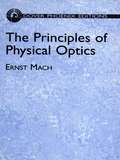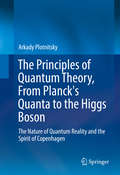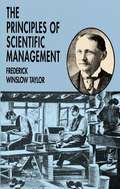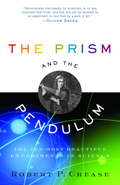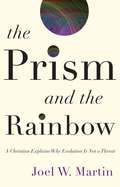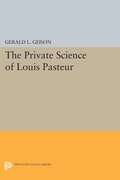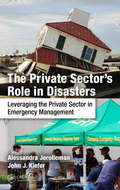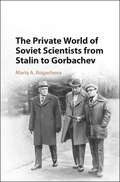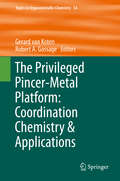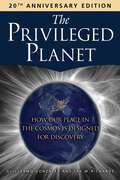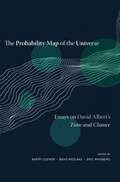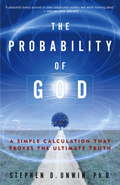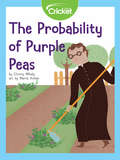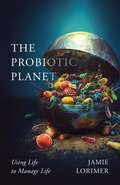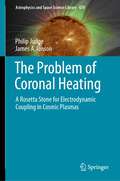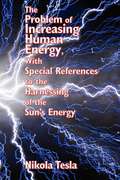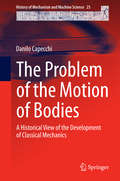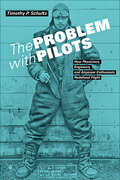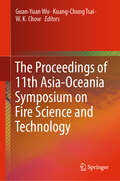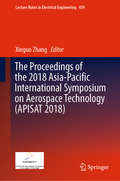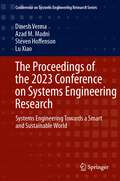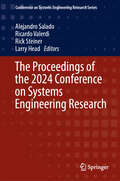- Table View
- List View
The Principles of Physical Optics: An Historical and Philosophical Treatment
by Ernst MachIn this classic exposition, Ernst Mach presents a detailed account of the experimental and theoretical evolution of our understanding of light phenomena and apparatus. Beginning with the philosophic and physiological speculation arising from early experiments on light and color perception, he proceeds to a thorough examination of the history of diopterics, including the roles of Huyghens, Galileo, Descartes, the Bernoullis, Kepler, and other scientists.Full descriptions of hundreds of experiments and detailed treatments of theory cover Newton's work with color and dispersion, his concept of the periodicity of light, the development of the theory of interference, and the perfection and elaboration of these ideas up until the mid-nineteenth century. A survey of polarization ranges from Bartholinus's paper on double refracting Iceland spar through work by Malus, Brewster, Biot, Arago, to the definitive work of Young and Fresnel. The final third of the book considers the mathematical representation of the properties of light; refinements in the theory of linear, circular, and elliptic polarization; and advanced diffraction experiments, including the theory of the diffraction grating.Students, teachers, and historians of science as well as physicists, engineers, designers of optical systems, and all readers interested in the development and perfection of scientific research will find this volume a stimulating and informative resource.
The Principles of Quantum Theory, From Planck's Quanta to the Higgs Boson
by Arkady PlotnitskyThe book considers foundational thinking in quantum theory, focusing on the role the fundamental principles and principle thinking there, including thinking that leads to the invention of new principles, which is, the book contends, one of the ultimate achievements of theoretical thinking in physics and beyond. The focus on principles, prominent during the rise and in the immediate aftermath of quantum theory, has been uncommon in more recent discussions and debates concerning it. The book argues, however, that exploring the fundamental principles and principle thinking is exceptionally helpful in addressing the key issues at stake in quantum foundations and the seemingly interminable debates concerning them. Principle thinking led to major breakthroughs throughout the history of quantum theory, beginning with the old quantum theory and quantum mechanics, the first definitive quantum theory, which it remains within its proper (nonrelativistic) scope. It has, the book also argues, been equally important in quantum field theory, which has been the frontier of quantum theory for quite a while now, and more recently, in quantum information theory, where principle thinking was given new prominence. The approach allows the book to develop a new understanding of both the history and philosophy of quantum theory, from Planck's quantum to the Higgs boson, and beyond, and of the thinking the key founding figures, such as Einstein, Bohr, Heisenberg, Schr#65533;dinger, and Dirac, as well as some among more recent theorists. The book also extensively considers the nature of quantum probability, and contains a new interpretation of quantum mechanics, "the statistical Copenhagen interpretation. " Overall, the book's argument is guided by what Heisenberg called "the spirit of Copenhagen," which is defined by three great divorces from the preceding foundational thinking in physics--reality from realism, probability from causality, and locality from relativity--and defined the fundamental principles of quantum theory accordingly.
The Principles of Scientific Management
by Frederick Winslow TaylorThe basis of modern organization and decision theory, this influential essay has motivated administrators and students of managerial technique for more than 80 years. The author discusses eliminating inefficiency through a system based on principles applicable to individual and collective activities. A ground-breaking, and still-inspiring work.
The Prism and the Pendulum
by Robert CreaseIs science beautiful? Yes, argues acclaimed philosopher and historian of science Robert P. Crease in this engaging exploration of history's most beautiful experiments. The result is an engrossing journey through nearly 2,500 years of scientific innovation. Along the way, we encounter glimpses into the personalities and creative thinking of some of the field's most interesting figures.We see the first measurement of the earth's circumference, accomplished in the third century B.C. by Eratosthenes using sticks, shadows, and simple geometry. We visit Foucault's mesmerizing pendulum, a cannonball suspended from the dome of the Panthéon in Paris that allows us to see the rotation of the earth on its axis. We meet Galileo--the only scientist with two experiments in the top ten--brilliantly drawing on his musical training to measure the speed of falling bodies. And we travel to the quantum world, in the most beautiful experiment of all.We also learn why these ten experiments exert such a powerful hold on our imaginations. From the ancient world to cutting-edge physics, these ten exhilarating moments reveal something fundamental about the world, pulling us out of confusion and revealing nature's elegance. The Prism and the Pendulum brings us face-to-face with the wonder of science.From the Hardcover edition.
The Prism and the Pendulum: The Ten Most Beautiful Experiments in Science
by Robert CreaseIs science beautiful? Yes, argues acclaimed philosopher and historian of science Robert P. Crease in this engaging exploration of history's most beautiful experiments. The result is an engrossing journey through nearly 2,500 years of scientific innovation. Along the way, we encounter glimpses into the personalities and creative thinking of some of the field's most interesting figures.We see the first measurement of the earth's circumference, accomplished in the third century B.C. by Eratosthenes using sticks, shadows, and simple geometry. We visit Foucault's mesmerizing pendulum, a cannonball suspended from the dome of the Panthéon in Paris that allows us to see the rotation of the earth on its axis. We meet Galileo--the only scientist with two experiments in the top ten--brilliantly drawing on his musical training to measure the speed of falling bodies. And we travel to the quantum world, in the most beautiful experiment of all.We also learn why these ten experiments exert such a powerful hold on our imaginations. From the ancient world to cutting-edge physics, these ten exhilarating moments reveal something fundamental about the world, pulling us out of confusion and revealing nature's elegance. The Prism and the Pendulum brings us face-to-face with the wonder of science.From the Hardcover edition.
The Prism and the Rainbow: A Christian Explains Why Evolution Is Not a Threat
by Joel W. MartinGod or Darwin? It is one of the most contentious conflicts of our time. It is also completely unnecessary, according to Joel W. Martin, an evolutionary biologist and ordained elder in the Presbyterian Church USA. In this slim but powerful book, Martin argues that it is not contradictory to be a practicing, faithful Christian who accepts the science of evolution. Martin finds that much of the controversy in the United States over evolution is manufactured and predicated on a complete—and sometimes willful—misapprehension of basic science. Science and religion, he says, serve different purposes and each seeks to answer questions that the other need never address. He believes that many of the polarizing debates about evolution distract from the deeper lessons of Christianity and that literal, fundamentalist readings of the Bible require the faithful to reject not just evolution but many of science's greatest discoveries.Just as the scientific explanation of rainbows is not meant to refute the biblical "rainbow" story of God’s promise, evolutionary theory is not a ploy to disavow the divine. Indeed, Martin shows that the majority of Christians worldwide accept the theory of evolution. He urges his fellow Christians to refuse to participate in the intellectually stifling debate over evolution and creationism/intelligent design.
The Prison House of the Circuit: Politics of Control from Analog to Digital
by Jeremy Packer Joshua Reeves Alexander Monea Paula Nuñez de Villavicencio Kathleen Oswald Kate MaddalenaHas society ceded its self-governance to technogovernance?The Prison House of the Circuit presents a history of digital media using circuits and circuitry to understand how power operates in the contemporary era. Through the conceptual vocabulary of the circuit, it offers a provocative model for thinking about governance and media.The authors, writing as a collective, provide a model for collective research and a genealogical framework that interrogates the rise of digital society through the lens of Foucault&’s ideas of governance, circulation, and power. The book includes five in-depth case studies investigating the transition from analog media to electronic and digital forms: military telegraphy and human–machine incorporation, the establishment of national electronic biopolitical governance in World War I, media as the means of extending spatial and temporal policing, automobility as the mechanism uniting mobility and media, and visual augmentation from Middle Ages spectacles to digital heads-up displays. The Prison House of the Circuit ultimately demonstrates how contemporary media came to create frictionless circulation to maximize control, efficacy, and state power.
The Private Science Of Louis Pasteur (Princeton Legacy Library)
by Gerald L. GeisonIn The Private Science of Louis Pasteur, Gerald Geison has written a controversial biography that finally penetrates the secrecy that has surrounded much of this legendary scientist's laboratory work. Geison uses Pasteur's laboratory notebooks, made available only recently, and his published papers to present a rich and full account of some of the most famous episodes in the history of science and their darker sides--for example, Pasteur's rush to develop the rabies vaccine and the human risks his haste entailed. The discrepancies between the public record and the "private science" of Louis Pasteur tell us as much about the man as they do about the highly competitive and political world he learned to master. Although experimental ingenuity served Pasteur well, he also owed much of his success to the polemical virtuosity and political savvy that won him unprecedented financial support from the French state during the late nineteenth century. But a close look at his greatest achievements raises ethical issues. In the case of Pasteur's widely publicized anthrax vaccine, Geison reveals its initial defects and how Pasteur, in order to avoid embarrassment, secretly incorporated a rival colleague's findings to make his version of the vaccine work. Pasteur's premature decision to apply his rabies treatment to his first animal-bite victims raises even deeper questions and must be understood not only in terms of the ethics of human experimentation and scientific method, but also in light of Pasteur's shift from a biological theory of immunity to a chemical theory--similar to ones he had often disparaged when advanced by his competitors. Through his vivid reconstruction of the professional rivalries as well as the national adulation that surrounded Pasteur, Geison places him in his wider cultural context. In giving Pasteur the close scrutiny his fame and achievements deserve, Geison's book offers compelling reading for anyone interested in the social and ethical dimensions of science. Originally published in 1995. The Princeton Legacy Library uses the latest print-on-demand technology to again make available previously out-of-print books from the distinguished backlist of Princeton University Press. These editions preserve the original texts of these important books while presenting them in durable paperback and hardcover editions. The goal of the Princeton Legacy Library is to vastly increase access to the rich scholarly heritage found in the thousands of books published by Princeton University Press since its founding in 1905.
The Private Sector's Role in Disasters: Leveraging the Private Sector in Emergency Management
by Alessandra Jerolleman John J. KieferThis book examines the role of the private sector in emergency management and how that role is changing through private sector intersections with government, government agencies, and the public sectors in all phases of emergency management. It particularly focuses on the areas in which government regulations and guidelines promote or encourage priv
The Private Sector's Role in Disasters: Leveraging the Private Sector in Emergency Management
by Alessandra Jerolleman John J. KieferThis book examines the role of the private sector in emergency management and how that role is changing through private sector intersections with government, government agencies, and the public sectors in all phases of emergency management. It particularly focuses on the areas in which government regulations and guidelines promote or encourage priv
The Private World of Soviet Scientists from Stalin to Gorbachev
by Rogacheva Maria A.Rogacheva sheds new light on the complex transition of Soviet society from Stalinism into the post-Stalin era. Using the case study of Chernogolovka, one of dozens of scientific towns built in the USSR under Khrushchev, she explains what motivated scientists to participate in the Soviet project during the Cold War. Rogacheva traces the history of this scientific community from its creation in 1956 through the Brezhnev period to paint a nuanced portrait of the living conditions, political outlook, and mentality of the local scientific intelligentsia. Utilizing new archival materials and an extensive oral history project, this book argues that Soviet scientists were not merely bought off by the Soviet state, but that they bought into the idealism and social optimism of the post-Stalin regime. Many shared the regime's belief in the progressive development of Soviet society on a scientific basis, and embraced their increased autonomy, material privileges and elite status.
The Privileged Pincer-Metal Platform: Coordination Chemistry & Applications
by Gerard Van Koten Robert A GossageThe series Topics in Organometallic Chemistry presents critical overviews of research results in organometallic chemistry. As our understanding of organometallic structure, properties and mechanisms increases, new ways are opened for the design of organometallic compounds and reactions tailored to the needs of such diverse areas as organic synthesis, medical research, biology and materials science. Thus the scope of coverage includes a broad range of topics in pure and applied organometallic chemistry, where new breakthroughs are being achieved that are of significance to a larger scientific audience. The individual volumes of Topics in Organometallic Chemistry are thematic. Review articles are generally invited by the volume editors.
The Privileged Planet: How Our Place in the Cosmos Is Designed for Discovery
by Guillermo Gonzalez Jay Wesley RichardsEarth. The Final FrontierContrary to popular belief, Earth is not an insignificant blip on the universe's radar. Our world proves anything but average in Guillermo Gonzalez and Jay W. Richards' The Privileged Planet: How Our Place in the Cosmos Is Designed for Discovery.But what exactly does Earth bring to the table? How does it prove its worth among numerous planets and constellations in the vastness of the Milky Way? In The Privileged Planet, you'll learn about the world's: life-sustaining capabilities water and its miraculous makeup protection by the planetary giantsAnd how our planet came into existence in the first place.rivileged Planet you will discover:Why the best scientific evidence refutes the misnamed Copernican Principle-the widely held idea that there is nothing special about Earth or its place in the universeWhy the sheer number and size of galaxies does not mean that Earth's capacity to sustain life is the result of blind chanceHow Earth is precisely positioned in the Milky Way-not only for life, but also to allow us to find answers to the greatest mysteries of the universeStriking ways in which water doesn't behave like most other liquids-and how each of its quirks makes it perfectly suited for the existence of creatures like usThe harmony of Earth and the Moon: how they work together to sustain Earthly life as one intricate system-and how that system produces the best solar eclipses where Earthly observers can see themHow Jupiter and Saturn protect Earth from cataclysmic destructionHow the laws and constants that govern the universe must be narrowly fine-tuned for the existence of any complex lifeThe Privileged Planet's astounding findings should lead any individual to reevaluate entrenched assumptions about the universe-and even to reconsider our very purpose on what so many have dismissed as nothing more than an accident of cosmic evolution.
The Probability Map of the Universe: Essays on David Albert’s <i>Time and Chance</i>
by Barry Loewer, Brad Weslake, and Eric WinsbergPhilosophers debate the ideas and implications of one of the most important contemporary works in the philosophy of science, David Albert’s Time and Chance.In the twenty-odd years since its publication, David Albert’s Time and Chance has been recognized as one of the most significant contemporary contributions to the philosophy of science. Here, philosophers and physicists explore the implications of Albert’s arguments and debate his solutions to some of the most intractable problems in theoretical physics.Albert has attempted to make sense of the tension between our best scientific pictures of the fundamental physical structure of the world and our everyday empirical experience of that world. In particular, he is concerned with problems arising from causality and the direction of time: defying common sense, almost all our basic scientific ideas suggest that whatever can happen can just as naturally happen in reverse. Focusing on Newtonian mechanics, Albert provides a systematic account of the temporal irreversibility of the Second Law of Thermodynamics, of the asymmetries in our epistemic access to the past and the future, and of our conviction that by acting now we can affect the future but not the past. He also generalizes the Newtonian picture to the quantum-mechanical case and suggests a deep potential connection between the problem of the direction of time and the quantum-mechanical measurement problem.The essays included in The Probability Map of the Universe develop, explore, and critique this account, while Albert himself replies. The result is an insightful discussion of the foundations of statistical mechanics and its relation to cosmology, the direction of time, and the metaphysical nature of laws and objective probability.
The Probability of God: A Simple Calculation That Proves the Ultimate Truth
by Dr. Stephen D. UnwinDoes God exist?This is probably the most debated question in the history of mankind. Scholars, scientists, and philosophers have spent their lifetimes trying to prove or disprove the existence of God, only to have their theories crucified by other scholars, scientists, and philosophers. Where the debate breaks down is in the ambiguities and colloquialisms of language. But, by using a universal, unambiguous language—namely, mathematics—can this question finally be answered definitively? That’s what Dr. Stephen Unwin attempts to do in this riveting, accessible, and witty book, The Probability of God.At its core, this groundbreaking book reveals how a math equation developed more than 200 years ago by noted European philosopher Thomas Bayes can be used to calculate the probability that God exists. The equation itself is much more complicated than a simple coin toss (heads, He’s up there running the show; tails, He’s not). Yet Dr. Unwin writes with a clarity that makes his mathematical proof easy for even the nonmathematician to understand and a verve that makes his book a delight to read. Leading you carefully through each step in his argument, he demonstrates in the end that God does indeed exist.Whether you’re a devout believer and agree with Dr. Unwin’s proof or are unsure about all things divine, you will find this provocative book enlightening and engaging.
The Probability of Purple Peas
by Christy MihalyWith the help of his pea plants, Gregor Mendel cracked the secret of heredity, how traits are passed from parents to children to grandchildren.
The Probiotic Planet: Using Life to Manage Life (Posthumanities #59)
by Jamie LorimerAssesses a promising new approach to restoring the health of our bodies and our planet Most of us are familiar with probiotics added to milk or yogurt to improve gastrointestinal health. In fact, the term refers to any intervention in which life is used to manage life—from the microscopic, like consuming fermented food to improve gut health, to macro approaches such as biological pest control and natural flood management. In this ambitious and original work, Jamie Lorimer offers a sweeping overview of diverse probiotic approaches and an insightful critique of their promise and limitations. During our current epoch—the Anthropocene—human activity has been the dominant influence on climate and the environment, leading to the loss of ecological abundance, diversity, and functionality. Lorimer describes cases in which scientists and managers are working with biological processes to improve human, environmental, and even planetary health, pursuing strategies that stand in contrast to the &“antibiotic approach&”: Big Pharma, extreme hygiene, and industrial agriculture. The Probiotic Planet focuses on two forms of &“rewilding&” occurring on vastly different scales. The first is the use of keystone species like wolves and beavers as part of landscape restoration. The second is the introduction of hookworms into human hosts to treat autoimmune disorders. In both cases, the goal is to improve environmental health, whether the environment being managed is planetary or human. Lorimer argues that, all too often, such interventions are viewed in isolation, and he calls for a rethinking of artificial barriers between science and policy. He also describes the stark and unequal geographies of the use of probiotic approaches and examines why these patterns exist. The author&’s preface provides a thoughtful discussion of the COVID-19 pandemic as it relates to the probiotic approach. Informed by deep engagement with microbiology, immunology, ecology, and conservation biology as well as food, agriculture, and waste management, The Probiotic Planet offers nothing less than a new paradigm for collaboration between the policy realm and the natural sciences.
The Problem of Coronal Heating: A Rosetta Stone for Electrodynamic Coupling in Cosmic Plasmas (Astrophysics and Space Science Library #470)
by Philip Judge James A. IonsonThis book reflects on 8 decades of research on one of the longest-standing unsolved problems in modern astrophysics: why does the Sun form a hot corona? The authors give a critical overview of the field and offer suggestions on how to bridge the chasm between what we can measure, and what we can calculate. They go back to basics to explain why the problem is difficult, where we have made progress and where we have not, to help the next generation of scientists devise novel techniques to crack such a long-lasting problem. A way forward is formulated centered around refutation, using Bayesian methods to propose and to try to reject hypotheses and models, and avoiding seduction by ``confirmation bias’’.This book is aimed at physicists, students and researchers interested in understanding, learning from and solving the coronal heating problem, in an era of new dedicated facilities such as the Parker Solar Probe and the Daniel K. Inouye Solar Telescope. Thebook will appeal to those interested in understanding research methods and how they are changing in the modern academic environment, particular in astrophysics and Earth sciences where remote sensing is essential.
The Problem of Increasing Human Energy, With Special References to the Harnessing of
by Nikola TeslaPart philosophical ponderings on humanity's relationship to the universe, part scientific extrapolation on what technological advancement might bring to that understanding, this long essay, first published in Century Illustrated Magazine in June 1900, is yet another example of the genius of Serbian inventor NIKOLA TESLA (1857-1943), the revolutionary scientist who forever changed the scientific fields of electricity and magnetism. From the possibilities presented by robotics to the "civilizing potency of aluminum," from a "self-acting engine" to one of the first proposals to use solar power to run industrial civilization, and much more, this is a wide-ranging but illuminating look into the thoughts of an unsung hero of scientific philosophy.
The Problem of the Motion of Bodies
by Danilo CapecchiThis book focuses on the way in which the problem of the motion of bodies has been viewed and approached over the course of human history. It is not another traditional history of mechanics but rather aims to enable the reader to fully understand the deeper ideas that inspired men, first in attempting to understand the mechanisms of motion and then in formulating theories with predictive as well as explanatory value. Given this objective, certain parts of the history of mechanics are neglected, such as fluid mechanics, statics and astronomy after Newton. On the other hand, due attention is paid, for example, to the history of thermodynamics, which has its own particular point of view on motion. Inspired in part by historical epistemology, the book examines the various views and theories of a given historical period (synchronic analysis) and then makes comparisons between different periods (diachronic analysis). In each period, one or two of the most meaningful contributions are selected for particular attention, instead of presenting a long inventory of scientific achievements.
The Problem with Pilots: How Physicians, Engineers, and Airpower Enthusiasts Redefined Flight
by Timothy P. SchultzAn illuminating look at how human vulnerability led to advances in aviation technology.As aircraft flew higher, faster, and farther in the early days of flight, pilots were exposed as vulnerable, inefficient, and dangerous. They asphyxiated or got the bends at high altitudes; they fainted during high-G maneuvers; they spiraled to the ground after encountering clouds or fog. Their capacity to commit fatal errors seemed boundless. The Problem with Pilots tells the story of how, in the years between the world wars, physicians and engineers sought new ways to address these difficulties and bridge the widening gap between human and machine performance.A former Air Force pilot, Timothy P. Schultz delves into archival sources to understand the evolution of the pilot–aircraft relationship. As aviation technology evolved and enthusiasts looked for ways to advance its military uses, pilots ceded hands-on control to sophisticated instrument-based control. By the early 1940s, pilots were sometimes evicted from aircraft in order to expand the potential of airpower—a phenomenon much more common in today's era of high-tech (and often unmanned) aircraft.Connecting historical developments to modern flight, this study provides an original view of how scientists and engineers brought together technological, medical, and human elements to transform the pilot's role. The Problem with Pilots does away with the illusion of pilot supremacy and yields new insights into our ever-changing relationship with intelligent machines.
The Proceedings of 11th Asia-Oceania Symposium on Fire Science and Technology
by Guan-Yuan Wu Kuang-Chung Tsai W. K. ChowThis book features selected papers from the 11th Asia-Oceania Symposium on Fire Science and Technology (AOSFST 2018), held in Taipei, Taiwan. Covering the entire spectrum of fire safety science, it focuses on research on fires, explosions, combustion science, heat transfer, fluid dynamics, risk analysis and structural engineering, as well as other topics. Presenting advanced scientific insights, the book introduces and advances new ideas in all areas of fire safety science. As such it is a valuable resource for academic researchers, fire safety engineers, and regulators of fire, construction and safety authorities. Further it provides new ideas for more efficient fire protection.
The Proceedings of the 2018 Asia-Pacific International Symposium on Aerospace Technology (Lecture Notes in Electrical Engineering #459)
by Xinguo ZhangThis book is a compilation of peer-reviewed papers from the 2018 Asia-Pacific International Symposium on Aerospace Technology (APISAT 2018). The symposium is a common endeavour between the four national aerospace societies in China, Australia, Korea and Japan, namely, the Chinese Society of Aeronautics and Astronautics (CSAA), Royal Aeronautical Society Australian Division (RAeS Australian Division), the Korean Society for Aeronautical and Space Sciences (KSAS) and the Japan Society for Aeronautical and Space Sciences (JSASS). APISAT is an annual event initiated in 2009 to provide an opportunity for researchers and engineers from Asia-Pacific countries to discuss current and future advanced topics in aeronautical and space engineering.
The Proceedings of the 2023 Conference on Systems Engineering Research: Systems Engineering Towards a Smart and Sustainable World (Conference on Systems Engineering Research Series)
by Azad M. Madni Dinesh Verma Lu Xiao Steven HoffensonThe 20th International Conference on Systems Engineering Research (CSER 2023) pushes the boundaries of systems engineering research and responds to new challenges for systems engineering. CSER 2023 invited researchers and practitioners to submit their work in alignment with the thematic focus on a smart and sustainable world. CSER was founded in 2003 by Stevens Institute of Technology and the University of Southern California, and in 2023 the conference returned to the Stevens campus in Hoboken, New Jersey.
The Proceedings of the 2024 Conference on Systems Engineering Research (Conference on Systems Engineering Research Series)
by Rick Steiner Ricardo Valerdi Alejandro Salado Larry HeadThe 22nd International Conference on Systems Engineering Research (CSER 2024) pushes the boundaries of systems engineering research and responds to new challenges for systems engineering. CSER was founded in 2003 by Stevens Institute of Technology and the University of Southern California. In 2024 the conference was hosted by the University of Arizona, home to the first-ever established Department of Systems Engineering. The following foundational research topics are included: • Scientific Foundations of Systems Engineering • Digital Engineering, Digital Twins • Digital Transformation • Advances in Model-Based Systems Engineering (MBSE) • Value-based and Agile Systems Engineering • Artificial Intelligence for Systems and Software Engineering (AI4SE) • Systems and Software Engineering for Artificial Intelligence (SE4AI) • Cybersecurity and System Security Engineering • Uncertainty and Complexity Management • Trust and Autonomous Systems • Human-Systems Integration • Systems of Systems • Social Systems Engineering • Systems Thinking • Advances in requirements engineering, systems architecture, systems integration, and verification and validation. The 21st Annual Conference on Systems Engineering Research (CSER 2024) was poised to push the boundaries of systems engineering, embracing a wide array of themes from its scientific underpinnings to the forefront of digital engineering transformation and the seamless integration of artificial intelligence within systems and software engineering. Delving into cutting-edge topics such as Model-Based Systems Engineering (MBSE), cybersecurity, and the management of uncertainty and complexity, CSER 2024 tackled the varied challenges and seize the opportunities emerging in the field. The conference's commitment to blending theoretical insights with practical innovations makes it a pivotal event for the systems engineering community.
